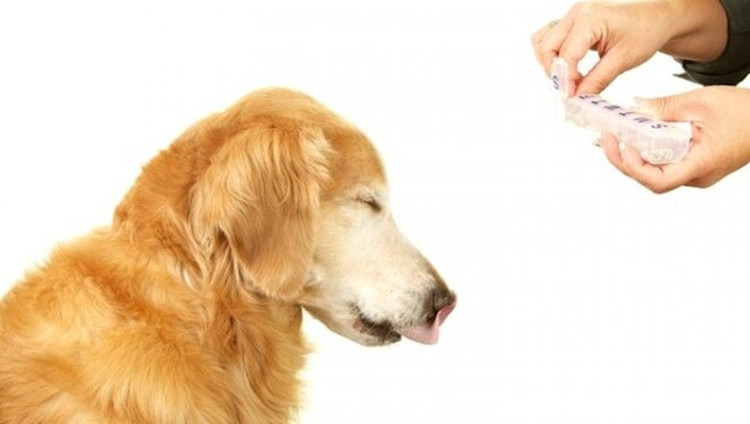- What is Benadryl?
- Can you give a dog Benadryl for allergies?
- Can you give a dog Benadryl for anxiety?
- Can my dog overdose on Benadryl?
- What are the side effects of Benadryl?
- When to avoid Benadryl?
- Key Takeaways
 (Image source: American Kennel Club)
(Image source: American Kennel Club)
What is Benadryl?
The active ingredient in Benadryl, diphenhydramine HCl, blocks receptors in the body that receive histamines triggered by an allergic reaction.
Note: a histamine is a compound released by cells in response to an inflammatory allergic reaction. Benadryl acts as an antihistamine, helping to relieve symptoms like sneezing, watery eyes, and itchy skin associated with seasonal allergies and environmental allergies experienced in both animals and humans.
Although the FDA does not yet approve it for veterinary use, many professionals recommend generic Benadryl as an over-the-counter (OTC) treatment for allergy symptoms and occasional motion sickness.
Can you give a dog Benadryl for allergies?
Benadryl may be an effective dog medication to use in canines with allergies. Seasonal, environmental, and food-related allergies — as well as allergic reactions to bites and stings — can be alleviated with diphenhydramine HCl.
A veterinarian may recommend your dog Benadryl to alleviate symptoms induced by an inflammatory histamine response, such as:
- Itchy skin
- Hives and rashes
- Sneezing
- Runny nose
- Coughing
- Teary eyes
- Redness
- Swelling and inflammation
- Anaphylactic reaction
It’s always wise to talk to your vet before introducing your pup to a new medication. Certain allergy symptoms (like red, itchy eyes) may be signs of a more severe condition, such as glaucoma, in which case Benadryl will not help.
In fact, if your canine companion does have glaucoma, the drug could make their condition worse. If you give your dog Benadryl, make sure to monitor your pet and call your vet if you notice an adverse reaction or unusual symptoms.
Keep in mind, Benadryl is only safe and effective for use in dogs experiencing mild to moderate allergic symptoms. If your dog displays symptoms of an acute allergic reaction to a food allergy with difficulty breathing, facial swelling, or severe itching, then take them to the vet as soon as possible. In these cases, the doctor may need to inject antihistamine so the drug can act more quickly.
Pro tip: An allergic reaction can last a few minutes or a few hours, but chronic allergy symptoms will be a part of your pup’s day-to-day life. Fortunately, these are manageable with the right medical supervision, and many pet insurance policies cover vet visits related to allergy issues.
Can you give a dog Benadryl for anxiety?
It depends on your vet’s recommendation. Benadryl can cause drowsiness, so some pet parents give it to their dog to alleviate anxiety triggered by loud thunderstorms, frequent fireworks, or separation from their favorite friend, to name a few examples.
While the medication is effective in the prevention of motion sickness, there may be better, more sustainable options to treat such nervous reactions. If you have a very anxious dog, you should talk to your vet to determine the best course of treatment. He or she may recommend alternatives to Benadryl such as:
- Behavioral training
- Environmental adjustments
- Pheromone treatments
- Natural remedies (i.e. anxiety vest or CBD oil)
Note that some dogs can have the opposite reaction to the drug, causing hyperactivity instead of calming them down. Work with a veterinarian to find a safe solution to soothe your pup’s anxiety.
Can my dog overdose on Benadryl?
Yes, if you give your dog too much Benadryl, it could result in potentially fatal diphenhydramine poisoning. If you’re wondering “What is the right Benadryl dosage for dogs?”, it’s best to call your veterinary office for a recommendtion based on your pet’s body weight and confirmation of it’s safe usage given their specific health history.
That said, you should always be watchful for potential signs of Benadryl overdose, including:
- Agitation
- Constipation
- Depression or hyperactivity
- Excessive salivating
- Dilated pupils
- Rapid heartbeat
- Rapid breathing
- Seizures
The safest bet is to seek professional advice before administering any medication. If you suspect your canine has an adverse reaction, get in touch with your vet or an emergency veterinary hospital right away.
 (Image source: Dog Time)
(Image source: Dog Time)
What are the side effects of Benadryl?
The most common side effects associated with using Benadryl for dogs include:
- Dry mouth
- Sedation
- Increased heart rate
- Hypersalivation
- Urinary retention
- Rapid breathing
Less common side effects are vomiting, diarrhea, rapid heartbeat, decreased appetite, and difficulty breathing. These typically occur within the first hour, so keep a close eye on your pup during this window of time. If you notice concerning symptoms, call your vet straight away.
When to avoid Benadryl?
Although Benadryl is well-tolerated by most dogs and seldom triggers adverse reactions, there are always safety risks involved with any drug — especially if your pup has certain medical conditions.
You should avoid giving your dog Benadryl if they have a history of:
- Cardiovascular disease
- Lung disease
- Bladder issues
- Enlarged prostate
- High blood pressure
- Glaucoma
- Epilepsy or seizures
- Previous bad reaction to the drug
Young puppies might not be able to consume Benadryl safely, so seek your vet’s professional opinion beforehand. You should also consult your vet before giving the drug to pregnant or nursing pets, as it’s typically not advised in these circumstances.
Combining different medications can also result in serious side effects, so if your pet is taking anything else, be sure to let your vet know when seeking their advice.
Final thoughts
So, can you give a dog Benadryl? Probably, depending on your pup’s specific history and health concerns. Benadryl is generally considered safe and effective for dogs, but only when used according to your vet’s specific instructions.
As with any new medication, keep an eye on your pup after administering the drug to ensure there are no concerning side effects or adverse reactions. If you have additional questions about using Benadryl for dogs, get in touch with your vet for more information.
